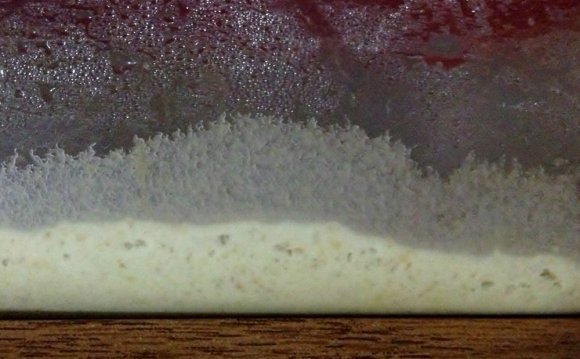
| Careful when you fish that male out of the tank! Make sure to not net fry as well. They are so small it is hard to see them. Lure the male away from the nest and THEN net him. Make sure to acclimate him back to his jar, make sure he has clean water and make sure to add bettamax to his water for a week. Bettas have a tendency to get sick after spawning, because spawning is strenuous for them and probably weakens their immune system. Torn fins will need to heal and Bettamax will prevent the infection of any wounds sustained during spawning. Feed your male, he is probably starving (that is if he hasn't been having a little midnight snack at the expense of his fry) ;). |
|
The first meal. Now that the fry have absorbed their entire yolk sac and are horizontal and swimming around, they must be fed. Feeding before that is a complete waste of time. Never put food inside a fry tank unless the fry are swimming horizontally and actually able to GET to the food (duh). Otherwise the food will rot and pollute the tank. So the first meal will be served promptly upon removal of the male, and consist of a small portion of microworms. I said SMALL. Of course since you cannot get microworms at your local Seven 11 (duh) you will need to order a culture at least 3 weeks prior to that first meal. Or else you are dead duck. Of course it would be real nice of you to order it from me, since I sell them, kinda like to support this website and say 'Hey Thanks Faith for spending all your free time building this site and giving me the betta info I need to succeed in my endeavors'. But please note I would praise endlessly the microworms even if I did not sell them. They are truly a fry and a life saver and I swear by them. As a matter of fact the reason I sell them is because I swear by them. Having said that, the first meal should be small, spreading the worms all over the tank’s floor so babies can easily find them, even if they are hanging out in the back. Don't overfeed. Microworms last long but after a few days they will die, so go easy at first. |
| Feed twice daily. After the first initial meal, you will need to feed twice a day. A must. Of course if you can still see live microworm at the bottom of your tank, then don't add some more. If you see a lot of dead microworm, kick yourself in the @#%^ a few times. You overfed! I cover fry food in the next few pages, so keep surfing my site for more details. Fry have the need for a lot of nutritious live foods, and since live foods stay alive for a while in the tank before dying, the fries can snack all day long :). It’s always a blast to see them gobble up brine shrimp or microworms, especially if you have a good magnifying glass handy. |
|
Turn lights off at night. Now you can turn the lights off at night and let the fry sleep. |
|
Leave them alone. Hands off!! Don’t fuss around too much with the fry. The less the better. Keep your big clumsy hands (you know the ones) out of that tank!! :) Make sure filter is barely bubbling still, and monitor temperature, which should be maintained at 80F. |
|
Cover the tank! Always keep a cover on your tank. Avoid cold drafts, especially the first 2 weeks. Keep conditions consistent. |
| Don’t add water (yet). For the first month or so, don’t add water level. Keep the tank where it’s at (about 1/2 empty). |
| Don’t overfeed to not unnecessarily pollute the tank. Every feeding, make sure the babies all have rounded bellies, but don‘t put so much food in there that it ends up uneaten and rotting at the tank‘s bottom. OVERFEEDING THE FRY WITH BABY BRINE SHRIMP WILL CAUSE SWIMBLADDER DISORDER!! You have been officially warned. Hugh. Wisest Buffalo has spoken. |
| Don’t clean the tank the first two weeks, unless there is a real problem, such as too much uneaten food rotting. For the first 2 weeks at least, I would leave the fry alone. If you have been obedient and did not spawn in a tiny tank, but instead followed my instructions and used a 5 or better yet, a 10 gal tank, you should be fine for the first two weeks. That is if you have a filter in there and if you are not overfeeding. |
|
Inspect the fry daily to spot any potential problems before they get out of hand. A few things could go wrong at this critical stage, such as tail rot, ich, velvet, or any number of bacterial diseases. Watch them fry like a hawk :) And at the first sign of problem, take prompt action. |
| Dead fry are not unusual. It is normal to find a dead fry in there every now and then. Some fry are just malformed or weak and will not make it through the first ten days. However if you start seeing 10 dead ones one day, ten more the next etc, then you have trouble coming your way my betta friend. An invisible enemy is killing your fry and if you don’t get off your you know what, they will all be dead by week’s end. So inspect them fry daily and watch them like a hawk. (did I say that already??) |









